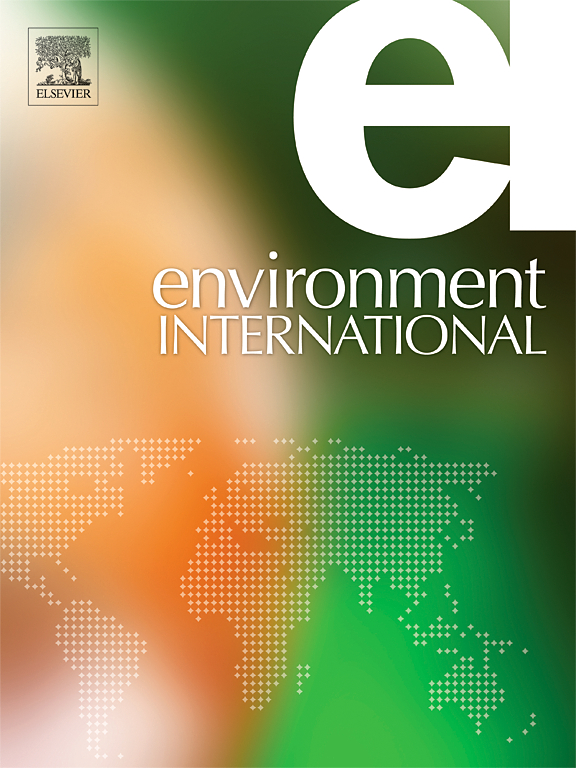揭示肠道的塑料困境:微塑料和纳米塑料如何驱动隐泥鳅不同的毒理学途径
IF 9.7
1区 环境科学与生态学
Q1 ENVIRONMENTAL SCIENCES
引用次数: 0
摘要
肠道微环境对维持宿主的健康至关重要。然而,目前对微塑料(MPs)和纳米塑料(NPs)的压力如何改变这种环境及其产生的生物毒性的机制理解有限。在这里,我们系统地研究了土壤无脊椎动物隐斑Enchytraeus crypticus暴露于环境相关浓度的聚苯乙烯MPs (50 μm)和NPs(100 nm)下的生物学反应——从生理学到病理学,从分子相互作用到表型变化。暴露在含有MPs和NPs的模拟土壤基质中,由于它们不同的胃肠道命运,不同地重塑了蠕虫的肠道微环境,从而通过不同的分子信号通路诱导不同的不良反应。NPs在肠道中的高生物蓄积潜力和长时间滞留促进了它们与肠道界面的相互作用,导致肠道酸化和H2O2在肠道中的过度积累。过量的H2O2作为一种信号分子,激活TNF信号通路,进而通过细胞凋亡干扰膜相关的脂质代谢,破坏肠道屏障的完整性。与NPs不同,MP在肠道中的积累刺激粘液分泌,作为对抗物理损伤的保护机制,但破坏脂肪消化和吸收途径,最终通过心磷脂介导的线粒体功能障碍和异常脂滴积累诱导细胞衰老。总的来说,我们的研究结果提供了在改变的内脏微环境下对MPs和NPs的不同生物学和分子反应的机制见解。本文章由计算机程序翻译,如有差异,请以英文原文为准。


Unveiling the gut’s plastic predicament: How micro- and nano-plastics drive distinct toxicological pathways in Enchytraeus crypticus
The gut microenvironment is crucial for maintaining health of its host. However, there is currently limited mechanistic understanding of how stress from microplastics (MPs) and nanoplastics (NPs) alter this environment and its resulting biotoxicity. Here, we systematically investigated the biological responses — from physiology to pathology and from molecular interactions to phenotypic changes — of the soil invertebrate Enchytraeus crypticus exposed to environmentally relevant concentrations of polystyrene MPs (50 μm) and NPs (100 nm). Exposure in a simulated soil matrix spiked with MPs and NPs differently reshaped the gut microenvironment of the worms due to their distinct gastrointestinal fate, thereby inducing different adverse effects via distinct molecular signaling pathways. The high bioaccumulation potential and prolonged retention of NPs in the gut facilitated their interaction with the gut interface, leading to gut acidification and an overaccumulation of H2O2 in gut. As a signal molecule, excessive H2O2 activated the TNF signaling pathway, which subsequently perturbed membrane-associated lipid metabolism and compromised gut barrier integrity through apoptosis. Unlike NPs, MP accumulation in the gut stimulated mucus secretion as a protective mechanism against physical damage, but disrupted fat digestion and absorption pathways, ultimately inducing cell aging through cardiolipin-mediated mitochondrial dysfunction alongside abnormal lipid droplet accumulation. Collectively, our findings provide mechanistic insights into the different biological and molecular responses to MPs and NPs within the context of an altered enchytraeid gut microenvironment.
求助全文
通过发布文献求助,成功后即可免费获取论文全文。
去求助
来源期刊

Environment International
环境科学-环境科学
CiteScore
21.90
自引率
3.40%
发文量
734
审稿时长
2.8 months
期刊介绍:
Environmental Health publishes manuscripts focusing on critical aspects of environmental and occupational medicine, including studies in toxicology and epidemiology, to illuminate the human health implications of exposure to environmental hazards. The journal adopts an open-access model and practices open peer review.
It caters to scientists and practitioners across all environmental science domains, directly or indirectly impacting human health and well-being. With a commitment to enhancing the prevention of environmentally-related health risks, Environmental Health serves as a public health journal for the community and scientists engaged in matters of public health significance concerning the environment.
 求助内容:
求助内容: 应助结果提醒方式:
应助结果提醒方式:


